Some of the best tools are bespoke – custom-designed for specific uses. In today’s article, we look at Roland’s latest DJ controller, the DJ-707M, which aims to fill as many needs as possible for mobile DJs. Is it a solid choice, and how well do the mobile DJ-focused features work? DJTT contributor DJ Soo investigates in today’s review.
The Life Of A Mobile DJ
It’s not always glamorous or artistically fulfilling, mobile DJ work can be one of the most lucrative things to do in our field. These DJs are there to entertain a mixed crowd, playing a diverse range of often mainstream, recognizable music.
They also are responsible for everything involved with the show: sound, lighting, visuals, staging, setup, teardown, etc. They are simultaneously the DJ, sound engineer, lighting technician, emcee, entertainer, and sometimes even event planners. Mobile DJs’ technical knowledge tends to be more about the ability to keep the show going: appealing to a broad audience, setting up and running the sound, running microphones for speeches, or handling audio requirements for multiple rooms and setups.
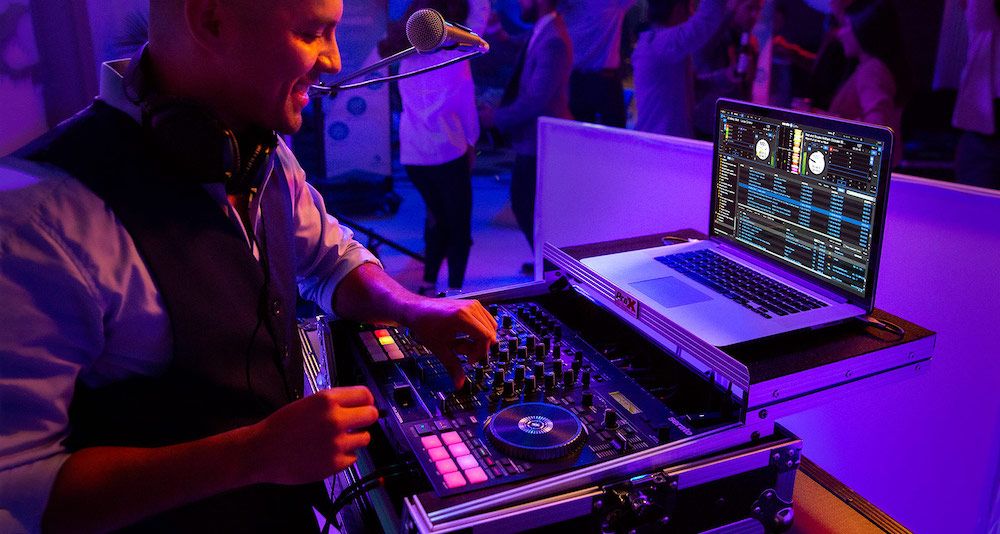
The gear required for these DJs is therefore much more extensive than the average DJ. Mobile DJs need to provide everything: speakers, lights, screens, microphones, additional mixers, speaker processing units, and more. Since mobile DJ operations tend to be one-person shows, space and weight requirements become a major factor in their purchasing choices.
It is these types of DJs that Roland has decided to focus on with their latest entry into the controller world: the DJ-707M.
The Focus Of This Review: Most DJ gear today has reached a level of parity and standardization across the board. As such, my reviews often skip the same and focus on the unique. With the 707M, there are some features that are absolutely unique to the unit that cannot be found in any controller – or even modular setup – on the market. There’s a lot to unpack with this controller despite its small stature, and I’ll outline and review the unique features available.
The Overview
- Controller: DJ-707M
- Manufacturer: Roland
- Price: $999
- Availability: Shipping in the DJTT store
On the surface, Roland’s $999 DJ-707M controller is a compact, relatively full featured Serato DJ enabled controller. It functions as a 4 channel controller that can also be used as a pure mixer, and can also be used as a DVS mixer with the additional paid Serato DVS plugin.
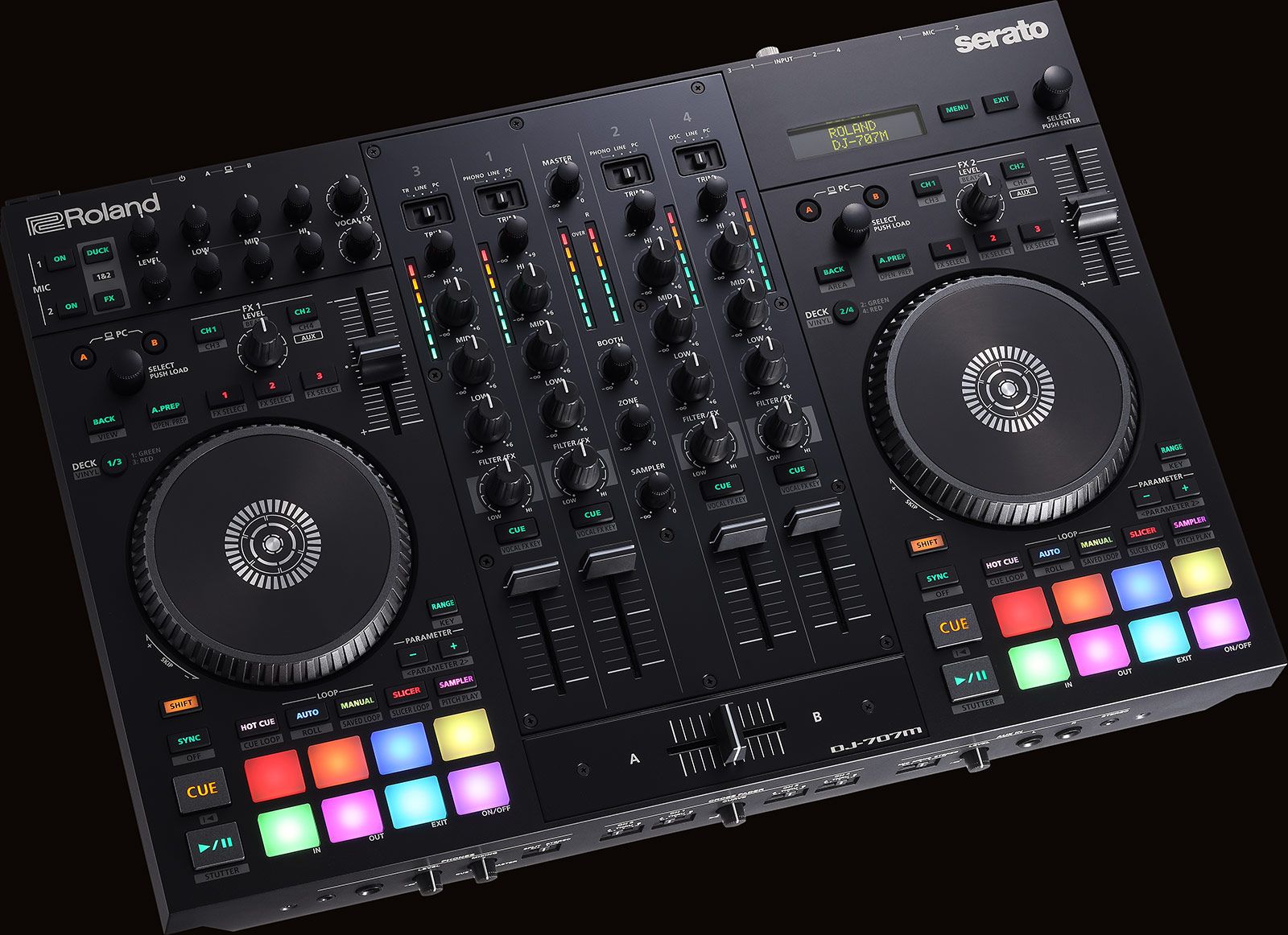
The real power of the controller lies “under the hood” so to speak in terms of the number of inputs and outputs available, as well as the complex routing and audio processing features that are built into the relatively small unit.
The 707’s Layout + Controls
Coming in at an ultra-light 7.7 lbs (3.5 kg), the DJ-707M is one of the smallest – and lightest – 4 channel controllers on the market. Size-wise, it is more comparable to the old Vestax VCI-400 or Denon MC6000 MK2 controllers rather than a Pioneer DDJ-SX style controller.
It has all the familiar controls one would expect from a controller: EQs, levels, browsing controls, pads, etc. The pads are a quite a bit smaller than most controllers, but all the Serato pad functions are available at the press of a button (or Shift and a button): Cues, Loops, Loop Roll, Slicer, Sampler, Pitch Play, and a few more.
Cueing is standard per-channel buttons, and the headphone volume controls are located at the front of the controller rather than on the face. They included a split cue feature, which is a bit of a rarity in the controller realm these days.
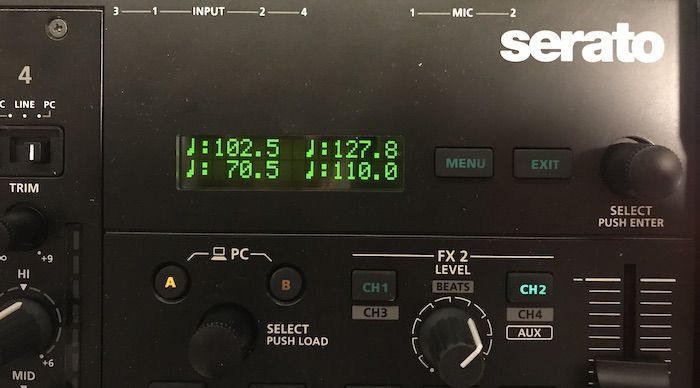
A tiny display window and a single encoder knob/button combo resides on the top right of the controller.
It’s used to control the various additional hardware features unique to the controller, as well as adjust a multitude of settings including things like pad sensitivity, crossfader cut, LED brightness, among others. The single knob is a little more intuitive than one would expect given the lack of screen real estate, but it does still require digging through the copious menus to adjust the settings. When left idle, the screen will display the BPM of all 4 channels – a very nice touch.
In order to fit so much functionality into the unit, there may be some standard controls that some DJs will miss. The most notable is in the effects section – which consolidates the three effects knobs into a single knob – as well as the lack of dedicated looping controls (which are handled by the aforementioned pads).
Build quality/overall feel:
The build quality on the DJ-707M is… alright. One of the biggest complaints about the previous DJ-505 controller was the overall cheap-feeling build and the 707M has thankfully improved the materials used. While it still nearly all plastic – with the only metal being the faceplate over the mixer portion of the controller – the overall sturdiness of the controller feels a lot better than the 505.
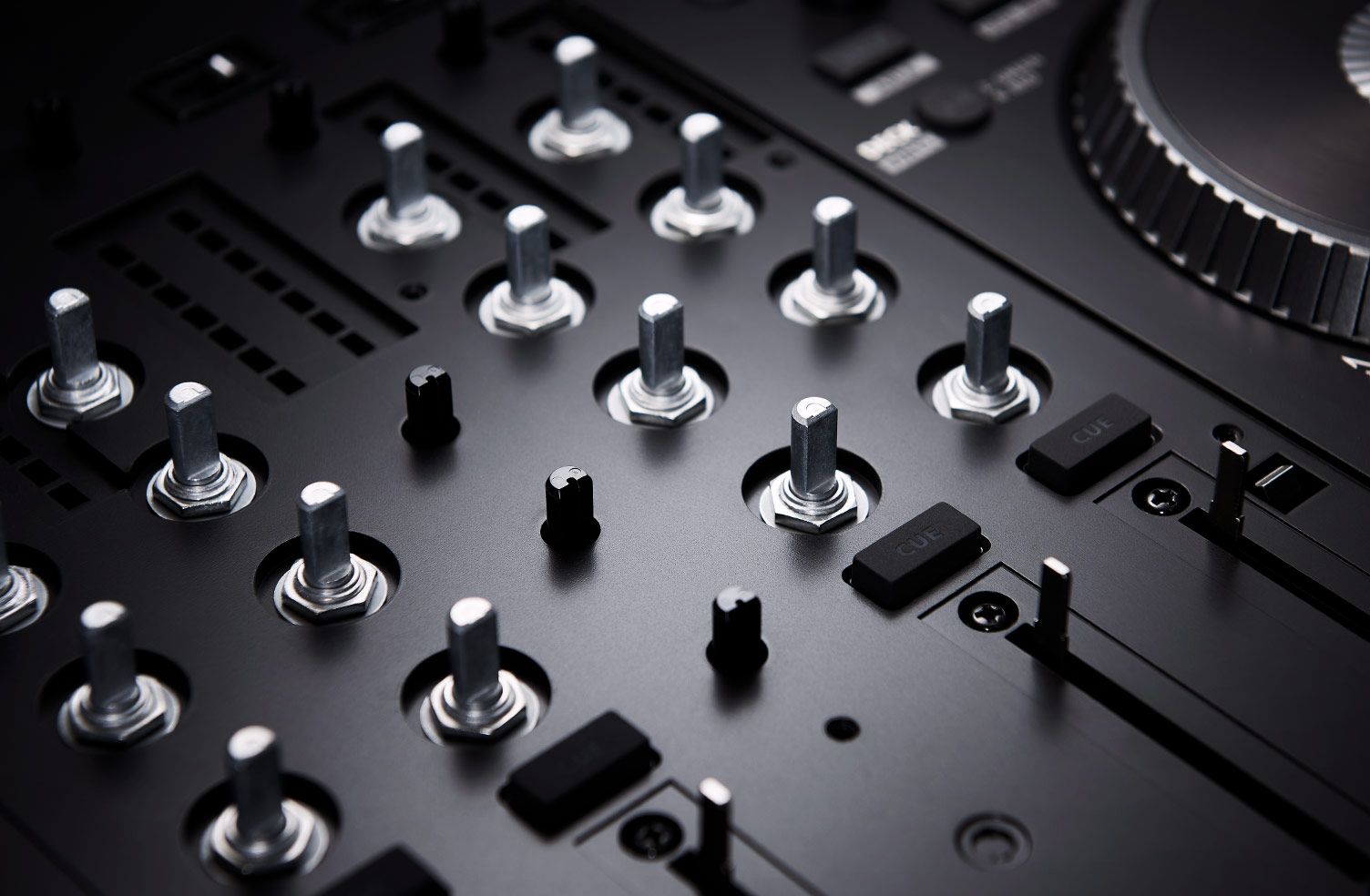
The controller still feels a little lighter than I’d care for. Heavier doesn’t necessarily mean better built, but there is a sort of reassuring feel to weightier and more rugged feeling controllers. Many mobile DJs will prefer the lighter feel as they’re often looking to shed as many pounds as possible when choosing equipment.
In terms of the DJ controls, the pads feel good, if a little stiffer than some other companies, and the click-y buttons feel adequate, although I did notice a few mis-fires with the play/pause and cue buttons – sometimes requiring a little firmer presses to get it working.
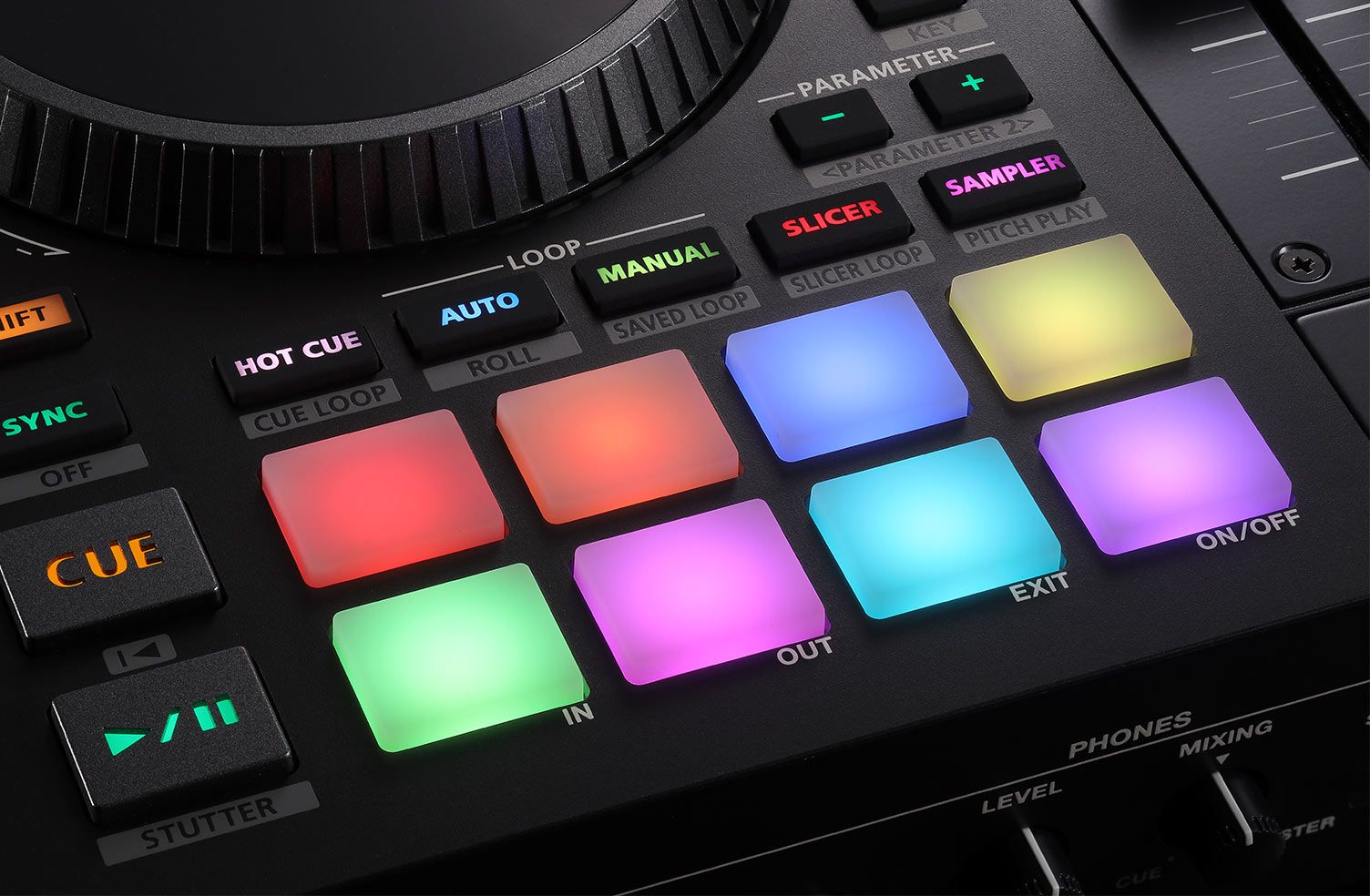
The knobs are thankfully a return to mainly metal stems that have always felt better than the plastic stems used in the 505 and 202 controllers.
The faders have a decent feel to them, but they do have some lateral wiggle which I don’t particularly like. I was very impressed by the feel of the crossfader though – both in terms of smoothness and in terms of the cut (adjustable in the settings screen). The line faders have more resistance to them and don’t feel quite as nice as the crossfader, but that’s pretty common.
All in all, the controller build feels good, but not great. Not as cheap feeling as the more entry level controllers out there, but also not as sturdy feeling as the top of the line controllers or the ones that utilize more metal in their materials. Long term user reviews will inform us if it will stand the test of time, but there is certainly nothing that stands out as problematic with the build.
Sound quality:
In my opinion, Roland makes the best sounding controllers on the market currently. This is a hill I’m willing to die on – and I’ve heard and compared a lot of gear over the years in a lot of different settings and sound systems. Yes, sound quality is ultimately subjective and a personal preference, but I’ve always felt that Roland has consistently punched well about its weight class with their included sound cards in their modern line of controllers, and the 707M is no different. There’s a warmth and presence that you usually only find in high end DJ mixers – many that cost well over twice the price of the Roland controllers and I put it up there in terms of sound quality to highly-touted sound-quality-focused brands like Allen & Heath or Rane.
The only minus I found in regards to sound quality is that playing vinyl did not really measure up to the excellent sound quality of digital files and line level audio. The phono preamps sounded a little dull, although far from the worst I’ve heard on DJ gear.
Inputs/Outputs:

The DJ-707M features 4 stereo, RCA inputs (two are phono/line switchable) – which allows it to double as a full 4 channel mixer. The unit also sports a pair of XLR mic inputs, an additional pair of 1/4” inputs that can be switched from a line level input to mic inputs, as well as an 1/8” stereo input on the same channel. These auxiliary inputs can be used for everything from connecting a phone to allowing live musicians to plug in their instruments.
There are 4 separate outputs available on the unit covering most of the popular connection types. The Master out has balanced, XLR outputs as well as RCA outs, the Booth out has balanced, 1/4” outputs, and the Zone outputs are RCA outputs. Each output section has its own volume knob (with the Master XLR and RCA outs sharing the same volume control). The amount and flexibility of these inputs and outputs allows the DJ-707M to be used as a relatively robust line mixer on its own saving the need to bring a separate mixer. The only thing I would have liked to see is the Zone outputs being a balanced jack with 1/4” or XLR outs.
The 707M also features a dual USB soundcard which is often used for seamless swapping of laptops. In the context of mobile DJing, dual USBs is especially useful for maintaining a backup laptop to avoid any technical issues in the high-pressure events synonymous with the job. The controller also sports an old school, 5 pin MIDI out port, useful for syncing clocks with other devices (including many of Roland’s own).
Microphone inputs/controls:
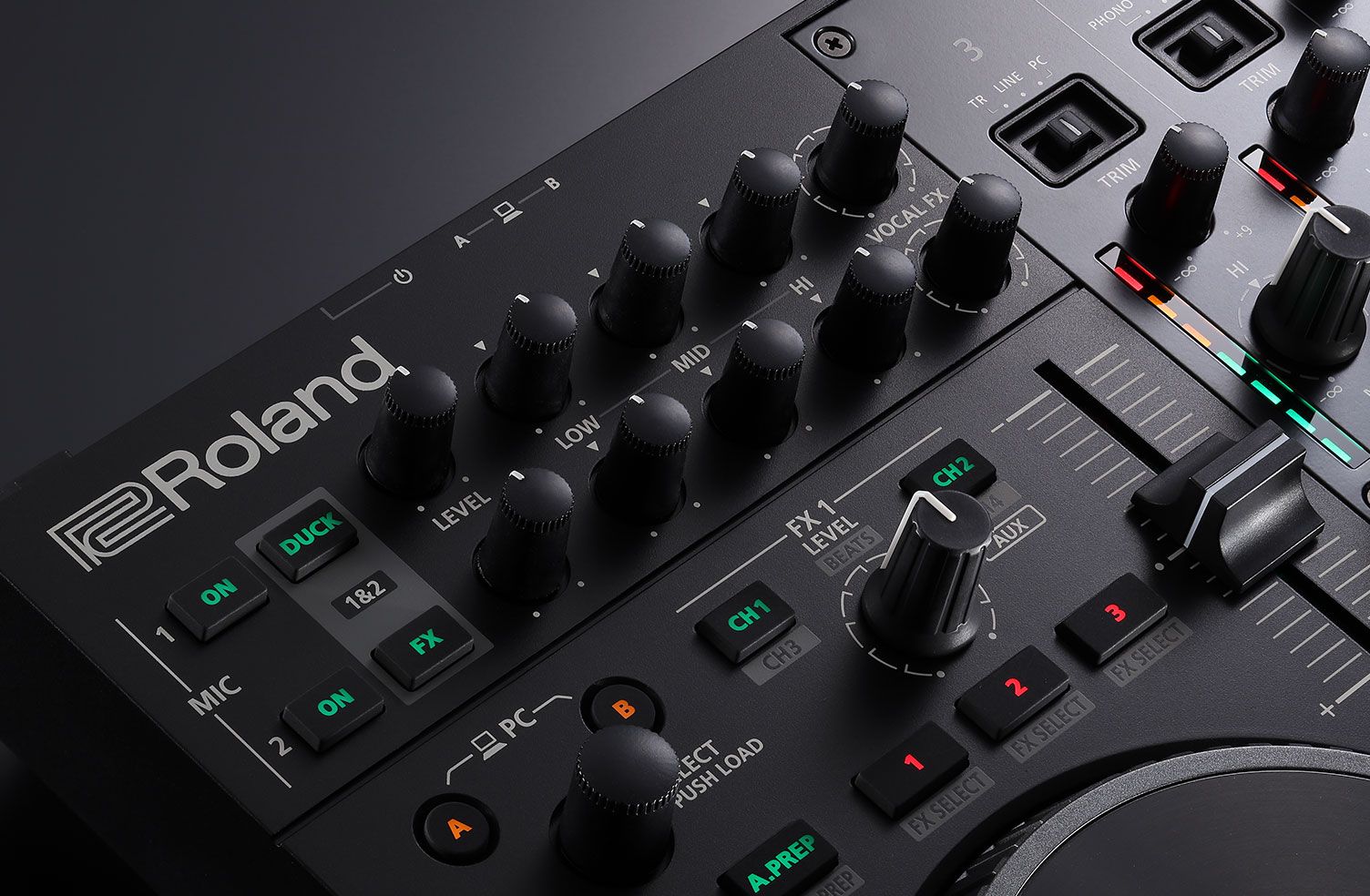
The two main Microphone inputs on the top left of the controller include a level knob, a three band EQ (switchable between a full kill isolator and regular EQ), as well as on/off controls, ducking controls, and dedicated effect controls. Each mic channel can be assigned an individual hardware effect from a suite of voice-specific effects – ranging from the fairly standard reverbs and delays, to some off-the-wall effects like harmonizers and robot filters – although only a single effect can be used at once.
Beyond effects, there are a number of settings you can apply to the mic signal including gain/attenuation, a low cut filter, a noise gate, panning, overall ducking settings, and ducking effect routing. I would have liked to have seen a compressor for the mic inputs as well, but that is unfortunately not available.
When I first tested the mic inputs, I found the default gain for the microphones a little high and I was experiencing some distortion even speaking at lower levels. When I dialed the internal mic gain back to about -18 db, everything sounded much better. Overall, I find the mic inputs to be very good – much higher quality than the average mic preamps usually included in controllers.
While the auxiliary inputs can also be used for microphones, they are far less robust in terms of controls – the pair of inputs is controlled by a single volume knob. While all the features like EQ, effects, ducking can also be applied to the aux inputs, they must be controlled via the screen and encoder rather than any dedicated controls.

The DJ-707M also touts an anti-feedback feature which is supposed to reduce mic feedback in live settings, but in my tests at home, I didn’t really notice a huge improvement. That said, this feature might shine in a specific real world setting.
Routing:
A unique feature of the DJ-707M is the ability to customize the all the audio routing for the various sources and outputs. Using the single encoder, any of the four music channels, mic channels, and aux channels – can be assigned to any of the three outputs.
This means DJs could have deck 4 and mic 2 assigned only to the Zone out, or Deck 3 and 4 and the aux input assigned only the Booth output.
One example of the use-case of this setup would be utilizing the Zone output to send a separate mix or playlist to a 2nd room; another would be sending out an completely unprocessed signal to a videographer in order to get the cleanest audio feed, or a feed that only includes the microphones, but not the music.
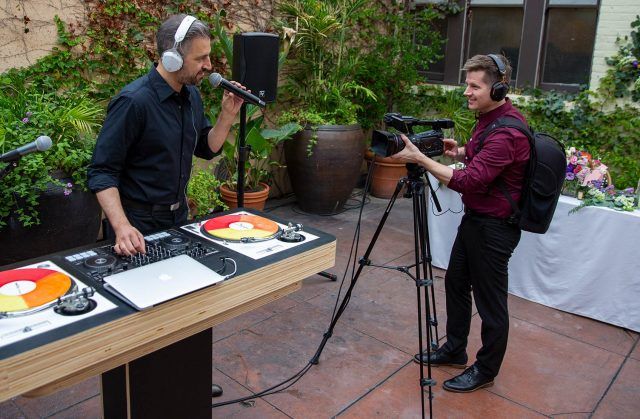
Before the DJ-707M, the only controller capable of something even close to this feature would be the Denon Prime 4 – and that is much less customizable than the DJ-707M.
Audio Processing:
One of the challenges of mobile sound is dealing with room acoustics. These change from venue to venue, as room size and shape can affect the overall sound quality of any given sound system.
To combat this, many higher end mobile DJs will often bring racks of audio processing units or a speaker management system like the popular dbx Driverack. By using EQs and various forms of compression and limiting on the master channels, the audio can be tuned to each room to reduce problematic frequencies and dial in overall sound quality.

The DJ-707M is the first DJ controller that includes built in audio processing features usually reserved pricy rack-mount units or higher end, digital, front-of-house line mixers.
The 707M includes a 4-band EQ with adjustable crossover points, multiband compression, a limiter, master attenuator, and a sub-output mode specifically for the Zone output. Used in conjunction with the powerful routing features, you can set different settings for each of the three outputs. While the UI and overall capabilities of the built in processing isn’t going to be quite as high level of a dedicated unit, it is still a very powerful set of features to be had in such a small unit.
One thing I would have liked to see was a proper crossover feature. While there is a dedicated Sub Out feature, there’s no way to match up high pass and low pass filters to fully separate the highs and lows.
Effects:
The DJ-707M utilizes a combination of Serato software effects and built-in hardware effects.
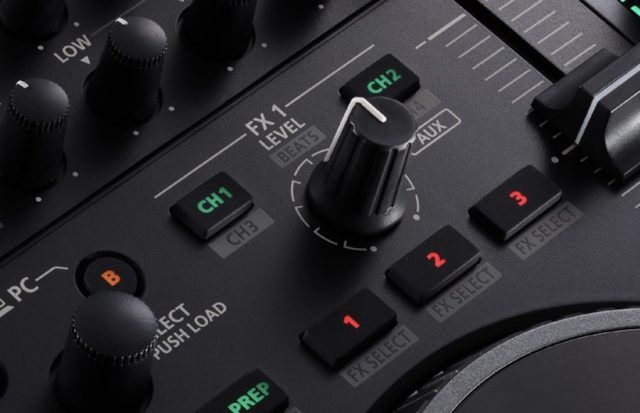
The software effects section utilizes a shared depth knob similar to the effects setup on something like the Pioneer SB3. While each individual effect can be triggered or turned on and off with a separate button, the depth levels are all controlled simultaneously by a single knob. This is not my favorite layout for effects by any means, but I doubt the target market of this controller is going to be doing much complex layering of effects and would probably be more focused on simple transition effects like echos and reverbs.
I also didn’t like how switching effect timing was handled by hold Shift and the depth knob. Because the depth knob is a linear knob, changing the timing would often result in a different knob position that you would set the depth. I would have preferred the effect timing to be bound to Shift + the Track Browse knob as having a separate knob makes more sense, and the track browse knob is right next to the depth knob.
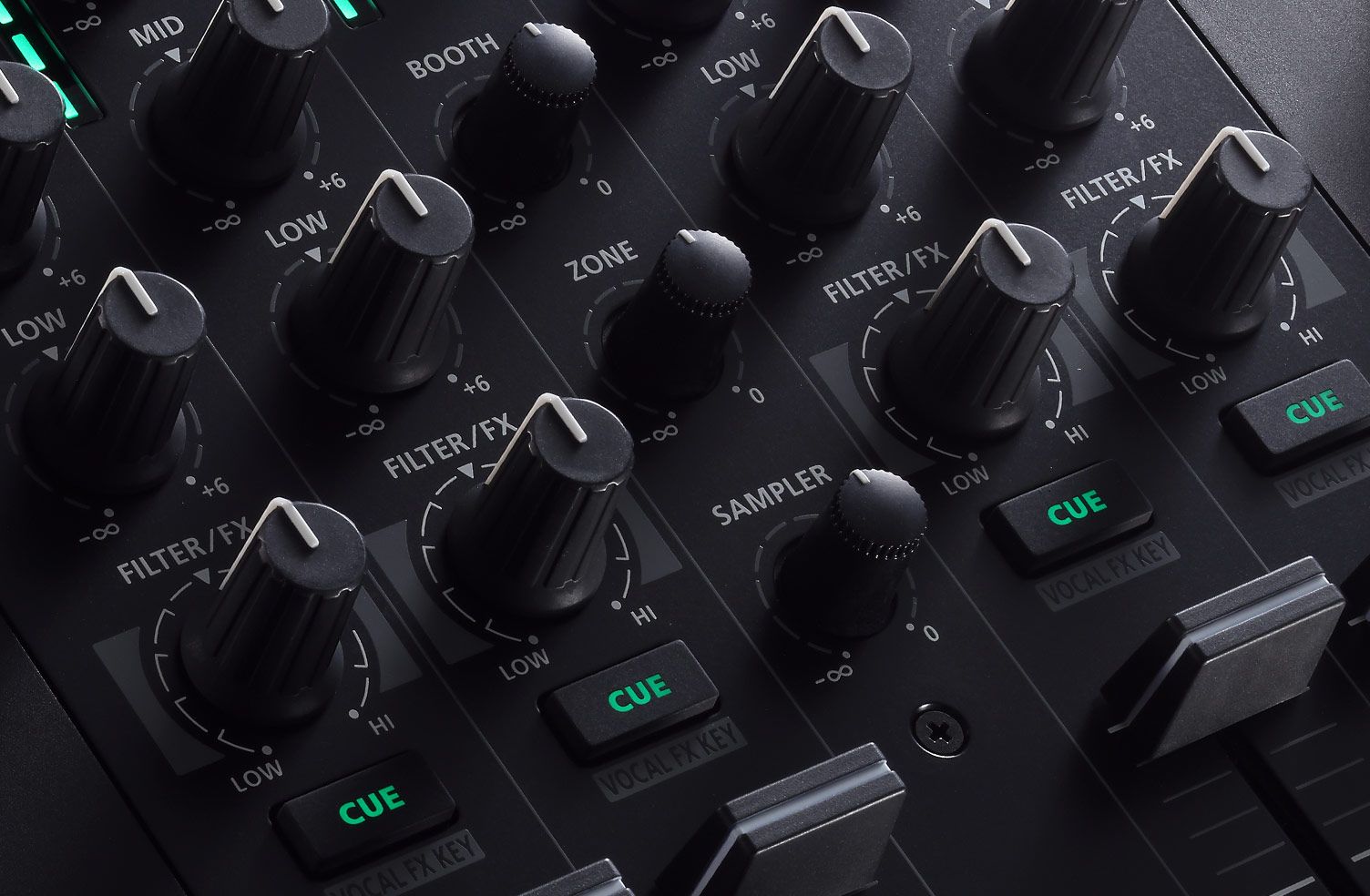
The hardware effects are controlled by the per-channel filter knob. The sweep effects can be changed on a channel-by-channel basis to a number of different options from standard echos and reverbs to some complex roll, pitching, and looper style effects. In theory, it gives you a very powerful suite of effects that can be triggered by the filter knobs, although in practice, the interface for changing the effects is pretty inefficient so it’s more likely you’d choose the effect you like, and leave it as is.
Scenes:
All the above settings can be set up and save to different preset “scenes” in the controller allowing for easy access to different setups. This can be especially useful if you frequent the same venues over the course of a season and can instantly recall optimal settings for any given room, or recall preset routings for different types of gigs.
Extras:
As with any Roland controller, the ubiquitous drum machine features are also included, albeit in a much more limited sense. Often used to beef up some older tracks with some more modern sounds layered underneath, the drum feature is much more limited than other Roland gear. Unlike other Roland controllers, the drum machine can only be used to play a selection of 16 pre-generated drum loops rather than having the sequencing features available. If you want to customize drum loops, it is possible to export loops made in the Roland TR-8S drum machine into the 707M.
There is also an Oscillator mode is accessible function as a sound effect bank with various sound effects that can be accessed without a laptop connected. I found the Oscillator pretty superfluous to be honest. The sounds weren’t so unique that they stood out, and it’s not anything that can’t be accomplished via the Serato Sampler. Just seemed like a completely unnecessary addition.
Each of these features can be assigned to the outer 2 channels on the mixer with the drum machine set to channel 3 (left) and the oscillator set to channel 4 (right) and the EQ and filter/color effects, and software effects can be applied to these channels.
One of the nice things about setting the drum loops to a channel, is that you have full control over the loops via the platter and pitch slider allowing you to manually beat match the drum loop in addition to just using the sync button – especially useful for layering under unquantized music. While you can’t scratch with the drum loops, the platter can be used to pitch bend the loops as if you were playing with the Vinyl mode turned off.
Dislikes + Elements of the DJ-707 That Need Work:
- DVS performance: While the compactness of the controller makes the option to use the 707M as a mixer between decks more attractive, I found the DVS tracking on turntables to be very problematic and somewhere between the preamps and the translation to Serato, something is going very wrong.
Any slow motions on the turntable results in the loss of tracking and the signal will essentially break up. While it’s perfectly usable in terms of straight up mixing, any sort of scratch that requires slow record movements is very difficult to pull off. This is, sadly a reoccurring problem with Roland as the DJ-505 also had problematic DVS where the signal would break up when using specific needles and scratching. I found no issues when using line-level devices like CDJs or turntables with built in preamps (and these issues do not occur in any other DVS capable device I own or use). - Platters: The capacitive touch platters, which feature the much-touted low-latency feel found on all Roland controllers, are very small – measuring 5” in diameter, but tapered inward leaving just 4 inches of surface platter to work with. While they feel very accurate, the small size simply feels limiting.
Scratching is possible on the platters, but it doesn’t feel great. In addition, the lack of any platter screens with position indicators is also a bit of a disappointment. I get that the target market of this controller is likely not going to be scratching at their gig, nor would they need the position indicators, but if you’re used to having them or used to a larger platter, it’s a little jarring moving to the comparatively tiny platters on the 707M. - Power supply: The 707M is primarily marketed to professionals – so most users would prefer an onboard power supply with a standard IEC plug instead of an included power brick. Aside from the paranoia of losing or forgetting the power supply, the overall quality of the brick and cables doesn’t inspire the most confidence. At my mobile gigs, I will have a minimum of 20 IEC cables stashed away so if one becomes problematic, I can simply swap it out for another. With the reliance on an AC adaptor, it’s a little more difficult to source proper fitting replacements – especially since 3rd party options can vary in quality and fit. This decision was likely to keep the size compact, but I think a lot of the target market would prefer a larger unit with a standard port.
- Gain Structure: The DJ-707M has a very uncommon gain structure to it. While most controllers and mixers tend to allow a comfortable gain level at anywhere from 11 – 12:00 on the knob, the DJ-707M needs the gain knob set at about 9:00 to stay out of the reds. Although it’s not that hard to adjust, it’s still a bit odd and takes some getting used to. While it is possible to change the gain sensitivity via the internal Serato gains, I found even the lowest setting for autogain to be not low enough and I didn’t want to individually adjust track gains to compensate, since it would affect usage on my other setups.
- Pitch Faders: Another casualty of the focus on compactness, the 60mm pitch faders are fairly standard for a controller this small. I still don’t really like it though and would prefer a longer throw fader. That said, the target market for this controller is likely going to be less concerned with pitch resolution.
- Hardware settings interface: While a single encoder knob to control such a complex toolbox is fairly intuitive, it is not the most efficient control scheme out there. It would be nice to have some type of larger interface available on the laptop including some more robust visual feedback. In a perfect world, I’d love to see a laptop control panel for the hardware features that is controllable via a wireless app on a smartphone or tablet. A lot of modern speaker management and digital console mixers now have a wireless option and the ability to tune the sound system wirelessly, and the ability to EQ a room from the dancefloor rather than from the DJ booth would be amazing.
An Overall Reflection on the DJ-707M
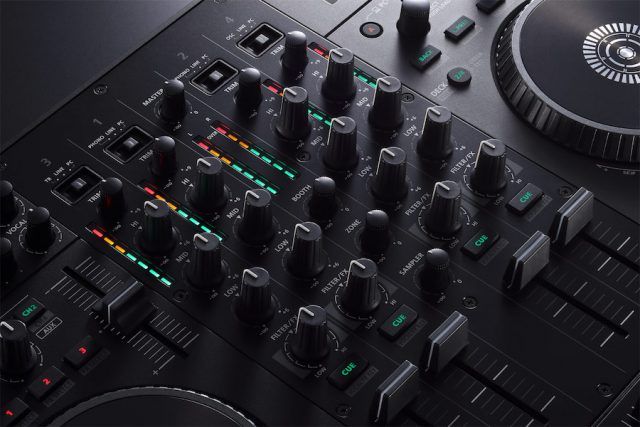
The Roland DJ-707M controller is ultimately a pretty niche product.
I’ve heard it referred to as the “Swiss Army knife” of controllers and I’m inclined to agree. This controller’s winning features aren’t exactly sexy, nor will a DMC champ be the best pick to show off the unit. Rather, it’s tailor-made for the professional event/mobile/wedding DJ that needs the versatility of mics, speaker/sound management, and routing options and mitigates the need to bring a bunch of extra equipment like mixers or processing racks. As a DJ that routinely brings well over 500 lbs of gear to my mobile gigs, every pound of lost weight and every inch of saved space becomes a very attractive notion.
I believe this controller would most appeal to veteran mobile DJs looking to shed some weight and gear for a simpler setup, or aspiring mobile DJs wanting to take the sound quality of their sound systems a little more seriously, but balk at the pricey add-ons like mixers and speaker processors that are required to get to that level.
The only product that I would say is even comparable to this controller would be the old Denon MC6000 MK2 – which was also heavily marketed to – and popular among – mobile DJs. But while the MC6000 was mainly touted for its quality mic inputs and professional level outputs, the 707M offers so much more in terms of functional and useful features.
The packed feature set coupled with the deliberate, compact design of the 707M does come at a price though. The platters, the effect controls, and some more standard dedicated controls all take a back seat in order to keep this controller compact. While the average mobile DJ may not be the most performance-focused at their gigs, there are still some that want both the functional features and the performance-oriented layout.
During my time with this controller, I played about 20 hours worth of events in two weekends. The lack of performance features and smaller size the platters were definitely an issue to me and I felt I had to dial back my style somewhat to compensate. My favorite setup using this controller was pairing it with my set of Denon SC3900s. With those, the DVS issue with turntables wasn’t present, but I still got to use the larger, spinning platters (as well as delve into some proper 4 deck mixing).
Ultimately, I feel this controller is a little hampered by the mandate to keep it compact. Some of the sacrifices required for such a densely packed controller might be too much for some people, but for those looking for a solid controller performance-wise, coupled with some incredibly useful and space saving features for the no-nonsense mobile DJ, there’s really nothing else like it on the market.
In the future, it’s very possible we may see a larger DJ-707M Pro or an DJ-808M with the best of both worlds, but for now, the Roland DJ-707M is absolutely unique, and the epitome of practicality over flash.





